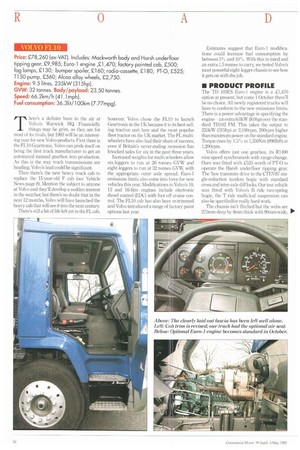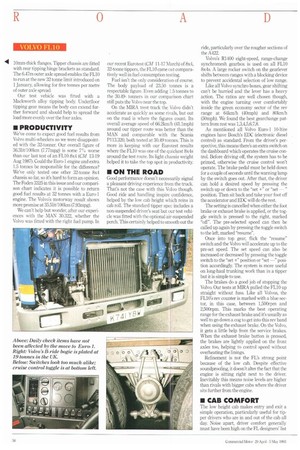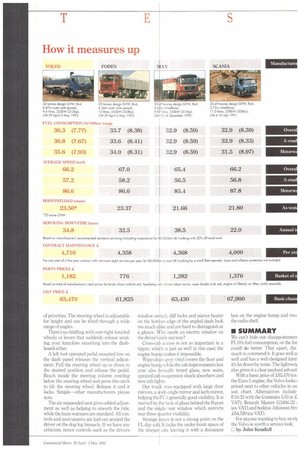Price: £78,260 (ex - VAT). Includes: Mackworth body and Harsh underfloor tipping
Page 56

Page 58

Page 59

If you've noticed an error in this article please click here to report it so we can fix it.
gear, £9,985; Euro-1 engine ,21,470; factory painted cab, £500; fog lamps, £130; bumper spoiler, £160; radio-cassette, 2180; P1-0, £525; T150 pump, £560; Alcoa alloy wheels, £2,750. Engine: 9.5 litres, 235kW (315hp).
GM: 32 tonnes. Body/payload: 23.50 tonnes. Speed: 66.2km/h (41.1mph).
Fuel consumption: 36.314/100km (7.77mpg).
There's a definite bun in the air at Volvo's Warwick HQ. Financially things may be grim, as they are for most of its rivals, but 1993 will be an interesting year for new Volvo products. First there is the FL10 Geartronic. Volvo can pride itself on being the first truck manufacturer to get an automated manual gearbox into production. As this is the way truck transmissions are heading, Volvo's lead could be significant.
Then there's the new heavy truck cab to replace the 15-year-old F alb (see Vehicle News page 8). Mention the subject to anyone at Volvo and they'll develop a sudden interest in the weather, but there's no doubt that in the next 12 months, Volvo will have launched the heavy cab that will see it into the next century.
There's still a bit of life left yet in the FL cab, however. Volvo chose the FL10 to launch Geartronic in the UK because it is its hest-selling tractive unit here and the most popular fleet tractor on the UK market. The FL multiwheelers have also had their share of success, even if Britain's never-ending recession has knocked sales for six in the past three years.
Increased weights for multi-wheelers allow six-leggers to run at 26 tonnes GVW and eight-leggers to run at 32 tonnes GVW, with the appropriate outer axle spread. Euro-1 emissions limits also come into force for new vehicles this year. Modifications to Volvo's 10, 12 and 16-litre engines include electronic diesel control (EDC) with foot-off cruise control. The FL10 cab has also been re-trimmed and Volvo introduced a range of factory paint options last year. Estimates suggest that Euro-1 modifications could increase fuel consumption by between 5% and 10%. With this in mind and an extra 1.5 tonnes to carry, we tested Volvo's most powerful eight-legger chassis to see how it gets on with the job.
• PRODUCT PROFILE
The TI) IMES Euro-I engine is a IAA?) option at present, but come 1 October there'll be no choice. All newly registered trucks will have to conform to the new emissions limits. There is a power advantage in specifying the engine an extra 6.0kW (8.0hp) over the standard TD102 FM. This takes the output to 235kW (315hp) at 2,100rpm, 200rpm higher than maximum power on the standard engine. Torque rises by 1.5 to 1,350Nm (996Ihft) at 1,20Orpm.
Volvo offers just one gearbox, its R1400 nine-speed synchromesh with range-change. Ours was fitted with £525 worth of PT-0 to operate the Harsh underfloor tipping gear. The 'box transmits drive to the CTEV87 single-reduction tandem bogie with standard cross and inter-axle dill locks. Our test vehicle was fitted with Volvo's B ride two-spring bogie, the T ride multi-leaf suspension can also be specifiedfor really hard work.
The chassis isn't flitched but the webs are 275mm deep by 8mm thick with 90min-wide, PP 10mm-thick flanges, Tipper chassis are fitted with rear tipping hinge brackets as standard. The 6.47m outer axle spread enables the FL10 to run at the new 32 tonne limit introduced on 1 January, allowing for five tonnes per metre of outer axle spread.
Our test vehicle was fitted with a Mackworth alloy tipping body. Underfloor tipping gear means the body can extend further forward and should help to spread the load more evenly over the four axles.
• PRODUCTIVITY
We've come to expect good fuel results from Volvo multi-wheelers so we were disappointed with the 32-tonner. Our overall figure of 3621it/100km (7.77mpg) is some 7% worse than our last test of an FL10 8x4 (CM 13-19 Aug 1987). Could the Euro-1 engine and extra 1.5 tonnes be responsible for the difference? We've only tested one other 32-tonne 8x4 chassis so far, so it's hard to form an opinion. The Foden 3325 in this issue and our comparison chart indicates it is possible to return good fuel results at 32 tonnes with a Euro-1 engine. The Volvo's motorway result shows more promise at 35.51ft/100km (7.93mpg).
We can't help but wonder, after our experiences with the MAN 30322, whether the Volvo was fitted with the right fuel pump. In
our recent Eurotest (CM 11-17 March) of 8x4, 32-tonne tippers, the FL10 came out comparatively well in fuel consumption testing.
Fuel isn't the only consideration of course. The body payload of 23.50 tonnes is a respectable figure. Even adding 1.5 tonnes to the 30.49winters in our comparison chart still puts the Volvo near the top.
On the MIRA trest track the Volvo didn't accelerate as quickly as some rivals, but out on the road is where the figures count. Its overall average speed of 66.2km/h (41.1mph) around our tipper route was better than the MAN and comparable with the Scania P113.320, both tested at 30.49 tonnes. This is more in keeping with our Eurotest results where the FL10 was one of the quickest 8x4s around the test route. Its light chassis weight helped it to take the top spot in productivity.
• ON THE ROAD
Good performance doesn't necessarily signal a pleasant driving experience from the truck. That's not the case with this Volvo though. Good ride and handling inspire confidence, helped by the low cab height which reins in cab roll. The standard tipper spec includes a non-suspended driver's seat but our test vehicle was fitted with the optional air-suspended perch. This certain ly helped to smooth out the ride, particularly over the rougher sections of the A422.
Volvo's R1400 eight-speed, range-change synchromesh gearbox is used on all FL10 8x4s. A large rocker switch on the gearlever shifts between ranges with a blocking device to prevent accidental selection of low range.
Like all Volvo synclup boxes, gear shifting can't be hurried and the lever has a heavy action. The ratios are well chosen though, with the engine turning over comfortably inside the green economy sector of the rev range at 64km/h (40mph) and 80km/h (50mph). We found the best gearchange pattern from rest was 1,3,4,5,6,7,8.
As mentiioned all Volvo Euro-1 10-hire engines have Bosch's EDC (electronic diesel control) as standard. From the driver's perspective, this means there's an extra switch on the dashboard which operates the cruise control. Before driving off, the system has to be primed, othenvise the cruise control won't operate. The brake pedal must be held down for a couple of seconds until the warning lamp by the switch goes out. After that, the driver can hold a desired speed by pressing the switch up or down to the "set +" or "set position. Then sit back and take your foot off the accelerator and EDC will do the rest.
The setting is cancelled when either the foot brake or exhaust brake is applied, or the toggle switch is pressed to the right, marked "off". The pre-selected speed can then be called up again by pressing the toggle switch to the left, marked "resume".
Once into top gear, flick the "resume" switch and the Volvo will accelerate up to the pre-set speed. The set speed can also be increased or decreased by pressing the toggle switch to the "set +" position or "set —" position accordingly. The system is more useful on long-haul trunking work than in a tipper but it is simple to use.
The brakes do a good job of stopping the Volvo. Our tests at MIRA pulled the FLIP up straight without fuss. Like all Volvos, the FL10's rev counter is marked with a blue sector, in this case, between 1,50Orpm and 2,500rpm. This marks the best operating range for the exhaust brake and it's usually as well to go down a cog to get into this rev band when using the exhaust brake. On the Volvo, it gets a little help from the service brakes. When the exhaust brake button is pressed, the brakes are lightly applied on the front axles too, helping to control speed without overheating the linings.
Refinement is not the FL's strong point because of the low cab. Despite effective soundproofing, it doesn't alter the fact that the engine is sitting right next to the driven Inevitably this means noise levels are higher than rivals with bigger cabs where the driver sits further from the engine.
• CAB COMFORT
The low height cab makes entry and exit a simple operation, particularly useful for tipper drivers who are in and out of the cab all day. Noise apart, driver comfort generally must have been high on the FL designers' list of priorities. The steering wheel is adjustable for height and can be tilted through a wide range of angles.
There's no fiddling with over-tight knurled wheels or levers that suddenly release sending your knuckles smashing into the dashboard either.
A left foot operated pedal mounted low on the dash panel releases the vertical adjustment. Pull the steering wheel up or down to the desired position and release the pedal. Reach inside the steering column cowling below the steering wheel and press the catch to tilt the steering wheel. Release it and it locks. Simple-other manufacturers please note.
The air-suspended seat gives added adjustment as well as helping to smooth the ride, while the burn-warmers are standard. All controls and instruments are laid out around the driver on the dog-leg binnacle. If we have any criticism, minor controls such as the drivers window switch, diff locks and mirror heater on the bottom edge of the angled dash look too much alike and are hard to distinguish at a glance. Who needs an electric window on the driver's side anyway?
Cross-cab access is not so important in a tipper, which is just as well in this case; the engine hump makes it impossible.
Wipe-clean grey vinyl covers the floor and engine hump while the cab improvements last year also brought tinted glass, new seats. uprated cab suspension shockabsorbers and new alb lights.
Our truck was equipped with large door mirrors, a wick-angle mirror and kerb mirror, helping the FT's generally good visibility. It is marred by the lack of glass behind the B-post and the single rear window which restricts rear three-quarter visibility.
Storage space is not a strong point on the FL day-cab. It lacks the under-bunk space of the sleeper cab, leaving it with a document box on the engine hump and two the radio shelf.
• SUMMARY
We can't hide our disappointmeni FLIO's fuel consumption, or the fee could do better. That apart, the much to commend it. It goes well al well and has a well-designed inter it's let down by noise. The lightweil also gives it a clear payload advant With a basic price of .C63,470 (ex. the Euro-I engine, the Volvo looks priced next to other vehicles in ou son chart. Alternatives include E10.32 with the Cununins L10 at VAT), Renault Maxter G340li.32 (ex-VAT) and Seddon Atkinson Stn £64,520 (exVAT).
For anyone wanting to buy an eis the Volvo is worth a serious look. C by John Kendall




















































































































